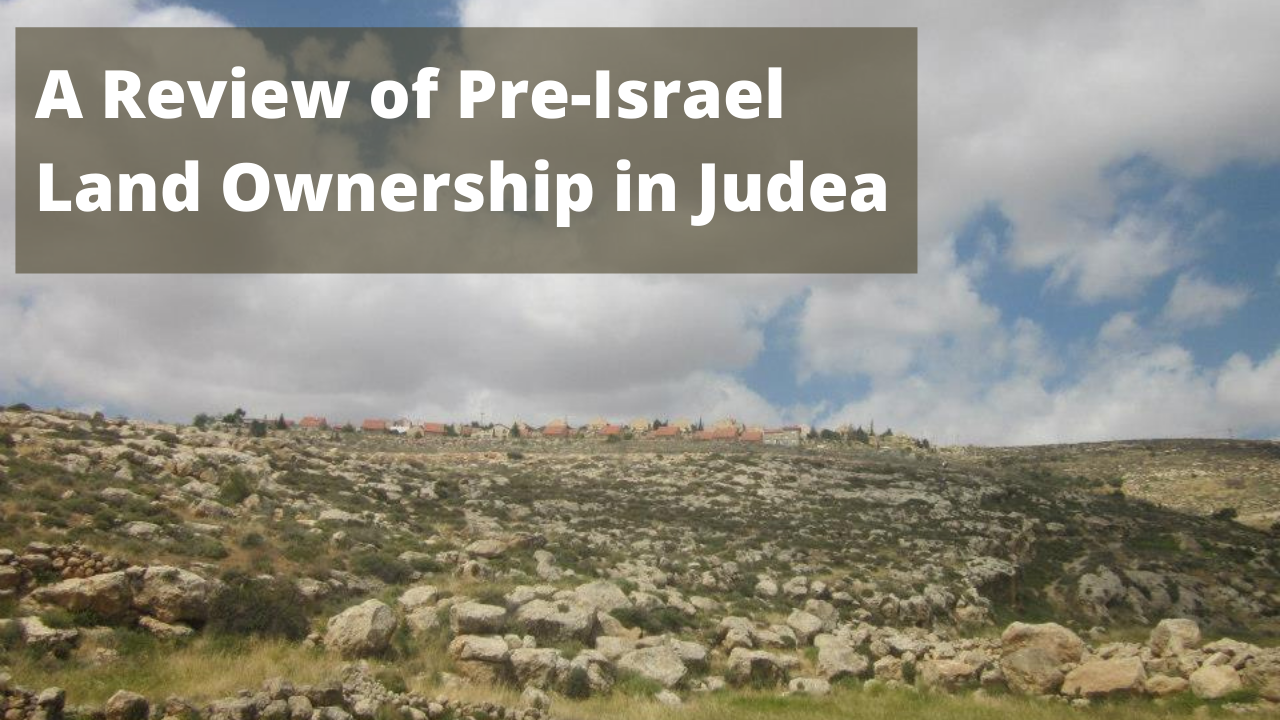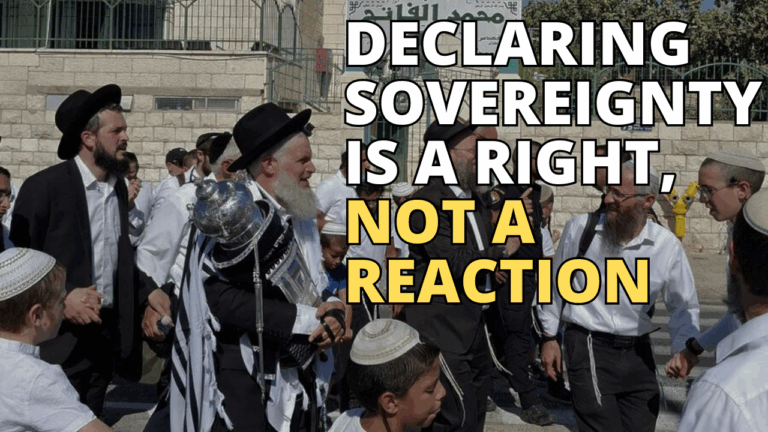A Review of Pre-Israel Land Ownership in Judea
A Review of Pre-Israel Land Ownership in Judea[1]
John D. Reisner
Arab and leftist mythmaking is never so industrious as when it turns its attention to the issue of ‘palestinian’ land rights. The habitual projection of leftists, in this regard, to smear Jewish reclamation of their property with the guilt of their own imperial sins serves to satiate a hatred that was otherwise stymied, until the early 70’s, by proximity to the Holocaust.
It is instructive to re-visit a dust gathering topic in order to measure the magnitude of the mendacity peddled by Arab and leftist propagandists. As with most of their lying, it takes but a moment to disseminate these falsehoods but 20 pages of dry facts to refute them.
The Arab/leftist narrative in this context rests upon two falsehoods of equally poor and borrowed manufacture:
- That the ‘palestinian’ farmer peacefully and contentedly worked his plot until dispossessed by the European Zionists and,
- That a small Jewish minority illegally made itself the controller of all of Syrian Palestine.
But for only minor rearrangement and no conceptual effort, these can be easily substituted for anything that was ever issued from the Reich Propaganda Ministry or Mein Kampf.
Under Turkish mis-management conditions in pre-19th century Palestine was a matter of steady decline. British Archaeologist Thomas Shaw described the area in 1738 as ‘lacking in people to till its fertile soil”.[2] Similarly French historian and sojourner Count Volney, in 1785, opined Palestine to be a ‘ruined’ and ‘desolate’ area.[3] Volney further observed the incessant warfare between peasants and the general Turkish dereliction in maintaining order; and being in constant conflict with the lawless Bedouin giving rise to a state of anarchy.
French invasion at the turn of the 18th century followed by Egyptian conquest and then later Turkish re-conquest of the area in 1840 coupled with the constant feuding between local chiefs, attacks by Bedouins, excessive taxation drove peasants out into the hills or out of the country altogether. Indebtedness ultimately drove remaining farmers to seek the protection of the Waqf that eventually compelled them to surrender their land title.
The situation in Judea in the middle of the 19th century before Jewish immigration is documented as being one of desolation, de-population and anarchy. H.B. Tristram provides a revealing description of complete collapse and desolation under Bedouin control.[4]
This description of desolation, lawlessness and de-population is confirmed in many travel logs of the time. Alexander Keith[5] (1844), Alphonse de Lamartine[6] (1835), W.F. Lynch[7] (1849) and famously Mark Twain[8](1867). A contemporary German encyclopaedia entry in 1827 calls Palestine ‘desolate and roamed through by Arab robber-bands’.[9]
A typical entry from Mark Twain’s account is, “Desolate country….a silent mournful expanse…We never saw a human being on the whole route”.
This devastating picture is repeated by Conder who visited Palestine in 1872 and again in 1881-1882 describes the depopulation and poverty found.[10] Christian historian James Parkes[11] documented the devastation contributed by peasant and Bedouin alike to the ‘ruin of the countryside’. He writes further ‘…….it is probable that in the first half of the 19th century the population sank to the lowest level it had ever known in historic times.’
The myth of an ‘ancient Palestinian people uprooted from its soil by Zionist colonization’ has the same provenance as all the anti-Semitic invective that was ever manufactured by National Socialism.
All this misery, chaos and displacement took place whilst any Jews there were still in Jerusalem, Hebron, Tiberias or Safed. When the Jews started buying the land from 1880 and breathing new life into the ravaged, neglected soil, the earlier trends began to reverse. Arabs started to return to jobs and economic activity created by Jewish capital and immigration.
Similarly, regarding the ‘antiquity’ of the ‘palestinian people’, often touted by the same propagandists in the same breath is unsurprisingly of the identical fabricated provenance. The Arabs of Palestine are not descended from Mohammedan conquests but from surrounding lands. Consider the following:
- Many of the Egyptian invaders who conquered Palestine in 1831, under Mohammed Ali, remained in the country even after the Turkish reconquest. They founded 8 villages along the central coastal plain and left permanent colonies of Egyptians in Beisan, Nablus, Irbid, Acre and Jaffa. A patchwork of peoples that made up the Palestine of the day are identified as Turks, Jews, Armenians, Greeks, Italians, Persians, Afghans, Motawila, Kurds, Germans, Bosnians, Circassians, Sudanese, Algerians and Samaritans.[12]
- In 1844 the American expedition under W.F. Lynch found 8000 Turks in Jaffa out of a total population of 13000.[13]
- De Haas identifies the Moslems of Safed as mostly descended of Moorish settlers i.e. Algerian tribes that fled to Damascus and then moved to Safed and Kurds who came earlier.[14]
- Lloyd George cites Lord Milner where colonies of Turkomans, Circassians, Kurds and other savage men had been planted about to hold the country in subjection.[15]
- James Parkes identifies over 20 villages in the Galilee alone whose inhabitants are from distant lands throughout the vast Ottoman Empire.[16]
The proposition of a ‘palestinian people’ reaching back into dim antiquity is clearly a mockery whose propagators hold in contempt the sagacity of their audience.
This also brings into focus recent criticisms emanating from Saudi Prince Bandar bin Sultan bin Abdulaziz that the Arab leadership of the ‘palestinians’ has been trafficking in the ‘palestinian’ issue as a means of lining their own pockets using the hundreds of billions of dollars issued them by Arab countries and the West to buy luxury planes and property in Europe and the US and to foment terror and destabilization against those Arab and other countries who do not yield to their gangsterism.
The reality is that the entire Arab League has been trafficking in the ‘palestinian’ issue whilst trying to leverage their oil power to extort compliance to suit their obscurantist, medieval interests.
The net result of the chaos that was in Palestine was the large scale abandonment of the plains and valleys. Most of the country’s 300,000 Arabs at the turn of the 20th century were to be found in the hilly regions. The Jews’ agricultural development efforts were directed to the largely uncultivated, sparsely settled, malarial, sandy plains and valleys. This is confirmed from Arab sources[17] and eyewitness accounts of the time in 1913 that appeared in the Report of the Palestine Royal Commission of 1937.[18]
Other reports confirm how Jewish energy transformed a country that was a matter of Arab, Turkish and Bedouin neglect and disinterest. The transformation of the Jezreel Valley from infested uninhabited malarial swamp in 1920 to a thriving rural hub with 2600 inhabitants in 1925 identifies this as resultant of an expenditure of £900,000 by the Jewish National Fund and others.[19]
The norm however was still Arab and Bedouin lawlessness, pillage and blackmail.[20] Individual plots of cultivation changed hands annually and there was little public security. This is reported by Mr. Lewis French, Director of Development appointed by the British Government in 1931.
Another major factor of the anarchy prevailing in Palestine in the closing decades of Turkish rule is the concentration of vast tracts of land in the hands of a relatively small number of absentee Arab landowners. According to Turkish sources in the second decade of the 20th century, 144 estate owners held a total area of 781,000 acres. 11 of these owners in Beersheba and Gaza districts owned over 25,000 acres each. The largest single estate was in the hands of the Sursuk family residing in Beirut and Egypt owning over 55,000 acres in the Jezreel Valley.[21]
In the closing decades of the 19th century and early quarter of the 20th the picture of Palestine that emerges is one of a land that was overwhelmingly desert and malarial swamplands with nomadic marauders and peasants wallowing in debt with interest rates sometimes as high as 60%. The ‘palestinian’ peasant was dispossessed by his fellow Arabs, local sheiks, village elders, tax collectors, merchants, absentee landlords, Bedouin marauders and moneylenders. This ‘normal’ course of events was disrupted by the advent of Jewish intervention which sounded the death knell of this medieval feudalism.
The subsequent Arab refusal to relinquish their property rights in their women and children, the cultural predisposition toward self-entitlement and supremacism; and the religious sanction provided to justify plunder forms the real basis of their ongoing complaints which are now embellished with outlandish historical and national claims that have less basis in fact than the fairy-tale stories of the brothers Grimm.
The Arabs received 99.99% of Ottoman possessions but their grievance is directed to the Jews who received the other 0.01% that was always theirs in the first place; and also that their habitual practices of plunder, dispossession and subjugation of the infidel had, in this case, been thwarted.
Jewish Land Purchases
Contrary to the invented narrative usually inflicted upon us by the usual parties, the first enduring agricultural settlement in Judea was founded by indigenous Palestinian Jews from old time families leaving the overcrowded Jewish Quarter of Old Jerusalem. [22] In 1878 they founded the village of Petah Tikva. Four years later a group of Jewish pioneers from Russia settled in Rishon le-Zion.
There are four factors to consider on this topic:
- Most land purchases involved large tracts belonging to absentee owners. The whole Jezreel Valley belonged to two persons. The Turkish Sultan and wealthy Syrian banker Sursuk.
- Most land purchases were uncultivated, swampy, rocky, sandy or otherwise regarded as uncultivable.
- For these reasons early transactions did not involve large sums of money. But the price of land began to rise as Arab landowners began to take advantage of Jewish demand.
- Jewish pioneers introduced new farming methods which improved the soil which were soon emulated by Arab farmers.
Between 1880 and 1947 50-90% of land purchase from all Jewish sources was made from large, usually absentee, owners. Of the over 100,000 acres purchased by PICA[23] close to 70% were large uncultivated tracts owned by absentee landowners. Another 10,000 acres were purchased from Government concessions bringing the total of PICA’s purchases to 117,351 acres, (or 469,407 dunams).
The records of the PLDC[24] show that 90% of their purchases were large tracts from private owners. Government concessions comprising lands in the sandy Beersheba and marshy Huleh districts came to approximately 16,500 acres. Their total purchases were 144,873 acres (or 579,492 dunams).
Of the 141,578 acres (566,312 dunams) bought by the JNF[25] from 1901-1947 90% of purchases until 1930 were large mostly uncultivated land tracts. This figure reduces to 50% to 1947. Individual Jewish purchases of 108,000 acres (or 432,100 dunams) followed this same purchase profile.[26]
British policy after the League of Nations Mandate deferred to Arab extremism in contravention of the Mandate. [27] In flagrant violation of the Mandate terms Britain allocated half of cultivatable state lands to the Arabs (some 87,500 acres) and less than 5% of this number to the Jews.
Similarly British policy was self-serving and illegal no matter what the Mandate obliged of them. In 1921 the British re-created the same detrimental feudal system of absentee land ownership by parcelling out land to 2 families who lived in Syria and 4 others who lived in Egypt in total over 3824 acres[28] and which by 1930 led to land speculation on a considerable scale.[29]
The Arab attitude to Palestine can be summarized by the following example. For two decades (1914-1934) the Huleh Concession (over 15,000 acres) was a swamp infested area in the north-east of the country. The Arabs were charged under the concession to drain the swamp and develop the land for cultivation under very attractive Government terms, first Turkish and then British. None of this was ever done. In 1934 the Concession was sold to the PLDC for an enormous profit and the government added onerous conditions to the sale that a certain amount had to be handed back over to Arab tenant-farmers without any re-imbursement for drainage and irrigation costs.
Hundreds of millions of dollars were paid by Jewish buyers to Arab landowners. In 1933 £854,796 was paid by Jewish individuals and organizations for Arab land, mostly large estates. In 1934 that figure was £1,647,836 and in 1935 a figure of £1,699,488 was paid.[30]
The magnitude of the prices paid is brought into focus by the following staggering statistic. In 1944 Jews paid between US$1,000 and US$1,100 per acre of arid or semi-arid land in Judea. In the same year the price of the rich black soils of Iowa were selling for US$110 per acre![31]
Conclusions
What is depressingly clear is that the colonialist/imperialist and expulsion narratives peddled by the assortment of Arab propagandists and leftist anti-Semites project a falsehood designed to cover for a desire to commit these same crimes on the Jews or to expunge their own or ancestral commission. Illegal Arab immigration into Palestine in contravention of British obligations under its League Mandate vary in estimates between 60,000 and 200,000, just in-between the two World Wars.[32]
At the time of Israel’s Independence official figures of the outgoing British Mandatory Administration, 8.6% of the land belonged to Jews, 3.3% to Arabs and 16.9% was abandoned by Arab owners who heeded the call from the invading Arab states to make way for the intended massacre. Over 70% of the rest of the land vested in the Mandatory Power was now the legal possession of the Israeli State.[33]
The greater part of this 70% was 3,144,250 acres (or less than half of Mandatory Palestine) was uninhabited arid or semi-arid territory inherited by the Mandatory Government from Turkey. These lands had not been owned by Arab farmers and the contention that 95% of the land had belonged to Arabs has absolutely no foundation in fact. [34],[35]
Palestine is but another long sorry example of an attempt, with a complicit British Government together with radical Arab extremism, to disenfranchise and plunder Jewish property, a habit acquired through many hundreds of years of practice in Islam and European Christendom. This habit found its culmination in Nazi Germany and has now become the principle activity of the Arab League, European Union and the UN.
The farce of Arab and other anti-Semitic claims over Palestine are a mockery that is beginning to unravel as Arab energy dominance starts to wane and their feudal, backward cultures begin to revert to their usual internecine destruction that is fuelled by their cultural elevation of all the basest human instincts.
The world-wide support provided to Arab terrorism, war-making and genocide will hopefully form the future basis of rightful Israeli material claims, in which the English should figure prominently.
The failure of the UN in contravention of its charter and raison d’etre to defend Israel, a UN member state, against Arab aggression; the failure to sanction Arab states who were and remain in contravention of every indictment of the IMT at Nuremberg; the unprecedented indulgence of the UN for Arab apartheid and racism in their non-resettlement of Arabs who mostly originate from their own states and their summary disenfranchisement of over 800,000 of their Jewish inhabitants.
[1] A Summary drawn from the Israel Academic Committee on the Middle East, Land Ownership in Palestine 1880-1948.
[2] Shaw, Thomas: Travels and Observations Relating to Several Parts of Barbary and the Levant, London 1767.
[3] Volney, C.F.: Travels Through Syria and Egypt in the Years 1783, 1784 and 1789, London 1787.
[4] Tristram, H.B.: The Land of Israel: A Journal of Travels in Palestine, Society for Promoting Christian Knowledge, London 1865, (pg.490).
[5] Keith, A: The Land of Israel (Edinburgh, 1844).
[6] Lamartine, A. de: Recollections of the East, Vol.1, pg.308 (London, 1835).
[7] Lynch, W.F.: Narrative of the United States Expedition to the River Jordan and the Dead Sea, pg.489, London, 1849.
[8] Twain, M.: The Innocents Abroad, pgs. 451, 480 (London 1881).
[9] Brockhaus: Allgemeine deutsche Real-Encyklopaedie, Vol.III, pg.206, Leipzig, 1827.
[10] Conder: Heth and Moah, pg.366, London, 1883.
[11] Parkes, J: Whose Land? (London, 1949).
[12] Encyclopaedia Britannica (Eleventh Edition, 1911); DeHaas: History of Palestine, pg. 419.
[13] Lynch, W.F., Ibid, pg. 446.
[14] DeHaas, Ibid, pg. 425.
[15] Lloyd-George, D: The Truth About Peace Treaties, Vol. II. Pg.1127.
[16] Parkes, J., Ibid, pgs.210-212.
[17] Kader, Abdel Razak, an Algerian Arab exile living in Paris described these conditions, The Jerusalem Post, Jan.08, 1969.
[18] Report of the Palestine Royal Commission (1937), Ch.9, para. 43.
[19] Report of the High Commissioner on the Administration of Palestine, 1920-1925, Colonial No. 15, London, 1925 pgs. 34-35.
[20] Tristram, H.B., Ibid, describes the plundering of the notorious Bedouin bandit Beni Sakk’r, pg.448.
[21] Orni, E.: Agrarian Reform and Social Progress in Israel, KKLI, Jerusalem 1972, pg. 50.
[22] The Turkish census of 1875 identified Jews as the majority of Jerusalem and by 1905 Jews constituted 40,000 of its 60,000 inhabitants as also noted in the Encyclopaedia Britannica of 1911.
[23] Palestine Jewish Colonization Association.
[24] Palestine Land Development Co.
[25] Jewish National Fund.
[26] Orni, E., Ibid, pg.52.
[27] Particularly Articles 5 and 11.
[28] Ghor-Mudawwarra Agreement of 1921 concerning Beisan, Opposed by Lewis French, Sir John Hope-Simpson and the Jews.
[29] Report of Sir John Hope-Simpson, 1930.
[30] Kader, Abdel Rezak, Ibid, ‘…small and large landed proprietors…queue up before the offices of the JNF to sell their lands at exorbitant prices.’
[31] US Department of Agriculture.
[32] Esco Foundation for Palestine, Inc., Palestine: A Study of Jewish, Arab and British Policies, Vol.1, Yale University Press, pgs. 229-230. According to the German Jurist E. Frankenstein, 75% of the Arab population of Palestine were immigrants or descendants of immigrants that came after 1882 due to Jewish colonization.
[33] Government of Palestine: Survey of Palestine, 1946, British Government Printer, pg. 257.
[34] Peel Commission Report 1936, ‘….little evidence that the (Arab) owners possessed either the resources or the training needed to develop the land.’
[35] Kader, Abdel Kader, Ibid, ‘The Palestinians who are today refugees in neighbouring countries….their present nationalist exploiters are the worthy sons of their feudal exploiters of yesterday, and that the thorns of their life are of Arab, not Jewish, origin.



